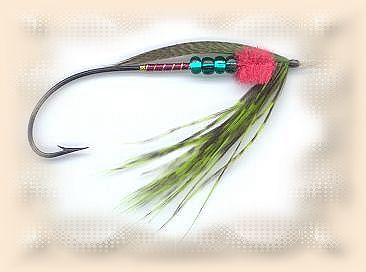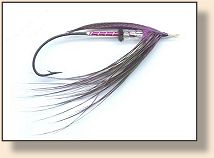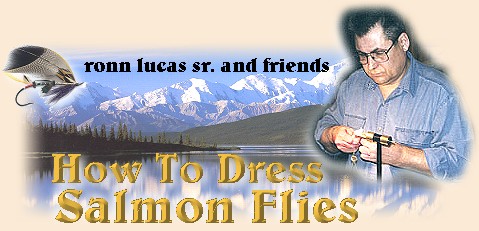Spey Hackle
 The term, Spey hackle can bring to mind several different
sizes, types and textured feathers. The history of Spey
Flies began in the UK. When Tyers tied the early Speys,
they were able to get feathers that are now illegal or
just don't exist at any price these days. When we use
Spey flies, we are usually attempting to imitate any of
several Crustaceans, aquatic insects or, just putting
something "buggy" in front of Salmon and/or Steelhead.
In "the salt" these fish feed on many things including
shrimp and, small fish. It isn't any coincidence that many
Spey Flies have a distinctive shrimp like appearance to them.
These flies often require long, soft barbed hackle to imitate
the legs, pincers and antennae of shrimp.
The term, Spey hackle can bring to mind several different
sizes, types and textured feathers. The history of Spey
Flies began in the UK. When Tyers tied the early Speys,
they were able to get feathers that are now illegal or
just don't exist at any price these days. When we use
Spey flies, we are usually attempting to imitate any of
several Crustaceans, aquatic insects or, just putting
something "buggy" in front of Salmon and/or Steelhead.
In "the salt" these fish feed on many things including
shrimp and, small fish. It isn't any coincidence that many
Spey Flies have a distinctive shrimp like appearance to them.
These flies often require long, soft barbed hackle to imitate
the legs, pincers and antennae of shrimp.
Among the original feathers used for Spey Flies were Heron,
Eagle and, the wide side feathers on the tail of the Rooster.
Of course, Eagle and Heron are not permitted any longer so,
alternatives had to be found. Later Tyers use shlapen (the
feathers in and around the tail of Roosters), Blue Eared
Pheasant (also the White and the Brown Eared Pheasants),
"burned" Goose feathers, marabou and, about any other soft
feathers that have some length to the barbs.
 The conventional ways to use these feathers were to either
strip one side of the feather or, to "fold" the hackle and
wrap the feather in the conventional manner. Tying the fly
in this manner will result with a bump at the head caused
by the bulk of the shaft (rachis). This bulk is even more
pronounced with some of the feathers whose shafts have a
"fast taper" to them, that is, the shaft goes from fine at
the tip to very thick a short distance down the shaft. The
bulky part of the shaft ends up right at the head and some
patterns require several wraps of the hackle at that point.
That bulk makes it difficult at best to tie in a wing that
sits low and, doesn't allow for a very small head in many
cases. Some feathers have finer shafts like schlapen than
others do. Good schlapen will have a very fine shaft for most
of its length. Blue Eared Pheasant has a relatively short
usable area of the feather and a thicker shaft than schlapen.
The Eared Pheasants have a distinctive texture though and it's
desirable for many patterns. To minimize bulk and get the effects
of multiple turns of hackle, the Tyer can tie the fly with a
"false" beard. That is, to tie a bunch of hackle barbs on at
the head without the shaft. This method works well enough for
many flies.
The conventional ways to use these feathers were to either
strip one side of the feather or, to "fold" the hackle and
wrap the feather in the conventional manner. Tying the fly
in this manner will result with a bump at the head caused
by the bulk of the shaft (rachis). This bulk is even more
pronounced with some of the feathers whose shafts have a
"fast taper" to them, that is, the shaft goes from fine at
the tip to very thick a short distance down the shaft. The
bulky part of the shaft ends up right at the head and some
patterns require several wraps of the hackle at that point.
That bulk makes it difficult at best to tie in a wing that
sits low and, doesn't allow for a very small head in many
cases. Some feathers have finer shafts like schlapen than
others do. Good schlapen will have a very fine shaft for most
of its length. Blue Eared Pheasant has a relatively short
usable area of the feather and a thicker shaft than schlapen.
The Eared Pheasants have a distinctive texture though and it's
desirable for many patterns. To minimize bulk and get the effects
of multiple turns of hackle, the Tyer can tie the fly with a
"false" beard. That is, to tie a bunch of hackle barbs on at
the head without the shaft. This method works well enough for
many flies.
For the last few years, I have been using feathers I have
removed the shafts from the hackle. This provides a hackle
that can be wrapped through the body and, several turns at
the head with virtually no bulk. The other big plus for
striping the shaft this way is that you end up with two
usable hackles rather than one, a factor to consider when
using expensive feathers. The technique for stripping is
simple and will work on almost any feather. The exceptions
are some feathers that have been burned, bleached and/or dyed.
These feathers tend to be brittle and do not strip well.

With this method, you can even strip the shaft from a Pheasant
tail and use it for hackle on your Speys although, these
hackles will be somewhat stiff. A few feathers can be
stripped dry but, many will end up breaking or, some of
the interior of the shaft may stick and need to be removed
later. As I said, the technique is simple but, the steps
are critical to ensure that you don't damage any hackles.
First, soak the feathers in soapy water overnight. Don't be
tempted to reduce this time, you will find that some feathers
will strip in less time but, again, some can be damaged. This
soaking will do two things. It will wash the feathers and,
also soften the interior of the shaft. A word of note, some
dyed feathers will loose color so, on them, shorter soaking
is necessary so they will retain their color. Or, you can strip
the hackles before dying as I do. When the feather is ready to
strip, hold the "good side" toward you. Pinch the tip with the
left hand, pinch the barbs just below the tip on the right side
of the feather with your right hand and pull almost straight
down slowly. Now, do the same on the other side. A word of
caution, concentrate on what you're doing as you pull the barbs
from the shaft. I have stripped thousands of feathers and still,
if I let my mind wander (as it's prone to do), I will break the
feather or render it mostly unusable. When this has been done
properly, you will end up with two strips of hackle and the
interior of the shaft. The right side of the feather will
wrap the conventional clockwise direction on the fly and the
left will wrap the opposite direction.
These stripped hackles are fairly fragile. I recommend counter
ribbing, that is, the opposite direction than the hackle, to
protect the hackle. Once tied this way, the resultant wing will
sit low and the head will be tiny.
The feathers I prefer are, Peafowl and several of the Pheasant
breeds in addition to the ones already mentioned that include
Swinhoe Pheasant. The Swinhoe has feathers that are almost black
but, have a deep blue color to them and, they are very soft.
The Peafowl feathers that I use are from 5" to 14" long with
barbs that are anywhere from ¾" to 2"+. These are not the
iridescent eyed feathers that they have during breeding
although many have some iridescence in them. They are the
feathers from the Peahen and young Peacocks. Another type
of feather found on Peafowl is the breast and/or flank feathers.
The male has more iridescent feathers than the hen but, both are
useful although often times many are somewhat short. Another
feather that is useful are the dark greenish feathers located
under the tippets of the Golden and Amherst Pheasants.

The bottom line with preparing hackles this way is:
A. more of the color and/or texture of the body of the
fly is left exposed to attract the attention of the fish,
B. a thinner body is possible,
C. the wing sits lower and,
D. a variety of feathers can be utilized that would not
normally be considered due to their structural limitations.
I can't say that you'll catch more or larger fish with flies
tied with this method but, you will have much more freedom
in selecting hackles than before.
Happy Trails! ~ Ronn Lucas, Sr.
Back to Index
|







